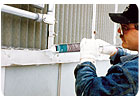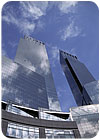

Dow Corning sealants are featured in the weatherproofing of the glass curtainwalls of the Time Warner Center in New York City. RSG Caulking & Waterproofing, one of the largest caulking installation companies in New York, has successfully used Dow Corning sealants on almost every project for the past 22 years.
- Dirt Pick-Up – Accumulation of dirt on a sealant’s surface is particularly prevalent on construction sites with large amounts of dust. The actual amount of dirt pick-up will vary with exposure conditions, but excessive pollutant contamination will result in lower durability and weaker bond strength. To avoid this, choose a sealant that can tolerate higher levels of contamination.
- Chalking – As the substrate begins to degrade and erode over time, the surface becomes more rough and porous, which leads to a loss of surface gloss and color. Chalking is most observed in organic sealants that are initially black or brown, but later transform into a light gray or beige. This does not occur with silicone or acrylic sealants.
- Change of Color – Color change can result from factors both inherent and external to the sealant. Incompatibility of the sealant with other building materials is a contributing factor. Materials with high incompatibility levels include low-molecular-weight polymers, antioxidants or tar. A sealant that is compatible with a variety of other substrates is preferable.
- Surface Crazing – A variety of factors, including sunlight, environmental stress and aging, can cause cracks in the sealant’s surface. This is especially common with organic sealants. Generally, sealants with higher polymer content are more durable and less subject to crazing.
- Fluid Migration – Fluids can migrate from a sealant to the substrate, creating a dark “wet” band look around the joint of the sealant. The extent and rate of fluid migration varies with the type of sealant. Cheaper, less formulated sealants are the most prone to staining and fluid migration.
- Other Environmental Factors – Oxygen, ultraviolet radiation, climate/temperature, microbial growth and other environmentally-induced mechanisms can contribute to the fatigue and stress that degrades and lowers the overall bond strength of the sealant.